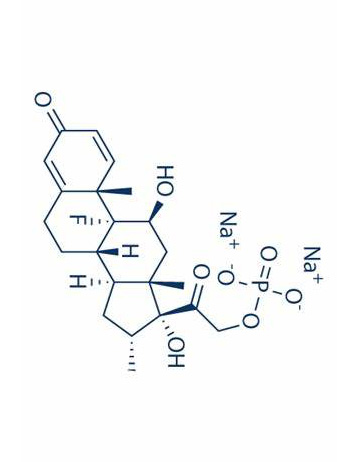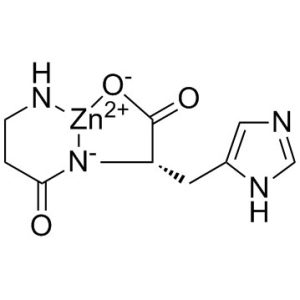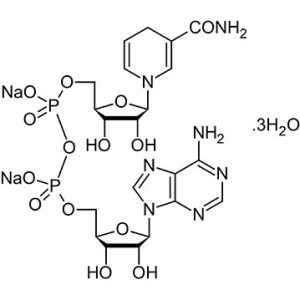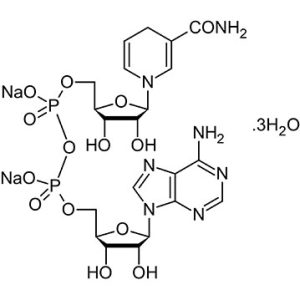dexamethasone sodium phosphate
Dexamethasone used to relieve inflammation and treat a variety of conditions that involve swelling, heat, redness, and pain in many body systems.
Description
Dexamethasone sodium phosphate, a synthetic adrenocortical steroid, is a white or slightly yellow, crystalline powder. It is freely soluble in water and is exceedingly hygroscopic. The molecular weight is 516.41. It is designated chemically as 9-fluoro-11β,17-dihydroxy-16α-methyl-21-(phosphonooxy) pregna-1, 4-diene-3,20-dione disodium salt. The empirical formula is C22H28FNa2O8P.
dexamethasone sodium phosphate Uses
dexamethasone sodium phosphate is a prescription medication used to relieve inflammation and treat a variety of conditions including:
1.arthritis
2.skin disorders
3.blood disorders
4.kidney disorders
5.eye disorders
6.thyroid disorders
7.intestinal disorders
8.systemic lupus erythematosus
9.dermatitis
10.psoriasis
11.allergies
12.asthma
Dexamethasone can also be used in the treatment of certain types of cancers.
Topical:
Dexamethasone is a prescription medication used to relieve inflammation and irritation, redness, burning, and swelling of the eye or ear caused by chemicals, heat, radiation, infection, allergy, or foreign bodies.
Intravitreal implant:
The intravitreal implant form of dexamethasone is used to treat macular edema, which involves fluid and protein deposits on the eye, and non-infectious uveitis, which is an inflammation of part of the eye.
This medication may be prescribed for other uses. Ask your doctor or pharmacist for more information.
Dexamethasone sodium phosphateINDICATIONS AND USAGE
A. By intravenous or intramuscular injection when oral therapy is not feasible
1. Endocrine disorders:
Primary or secondary adrenocortical insufficiency (hydrocortisone or cortisone is the drug of choice; synthetic analogs may be used in conjunction with mineralocorticoids where applicable; in infancy, mineralocorticoid supplementation is of particular importance).
Acute adrenocortical insufficiency (hydrocortisone or cortisone is the drug of choice; mineralocorticoid supplementation may be necessary, particularly when synthetic analogs are used).
Preoperatively, and in the event of serious trauma or illness, in patients with known adrenal insufficiency or when adrenocortical reserve is doubtful.
Shock unresponsive to conventional therapy if adrenocortical insufficiency exists or is suspected.
Congenital adrenal hyperplasia.
Nonsuppurative thyroiditis.
Hypercalcemia associated with cancer.
2.Rheumatic Disorders:
As adjunctive therapy for short-term administration (to tide the patient over an acute episode or exacerbation) in:
Post-traumatic osteoarthritis.
Synovitis of osteoarthritis.
Rheumatoid arthritis, including juvenile rheumatoid arthritis (selected cases may require low-dose maintenance therapy).
Acute and subacute bursitis.
Epicondylitis.
Acute nonspecific tenosynovitis.
Acute gouty arthritis.
Psoriatic arthritis.
Ankylosing spondylitis.
3.Collagen Diseases:
During an exacerbation or as maintenance therapy in selected cases of:
Systemic lupus erythematosus.
Acute rheumatic carditis.
4.Dermatologic Diseases:
Pemphigus.
Severe erythema multiforme. (Stevens-Johnson Syndrome)
Exfoliative dermatitis.
Bullous dermatitis herpetiformis.
Severe seborrheic dermatitis.
Severe psoriasis.
Mycosis fungoides.
5.Allergic States:
Control of severe or incapacitating allergic conditions intractable to adequate trials of conventional treatment in:
Bronchial asthma.
Contact dermatitis.
Atopic dermatitis.
Serum sickness.
Seasonal or perennial allergic rhinitis.
Drug hypersensitivity reactions.
Urticarial transfusion reactions.
Acute noninfectious laryngeal edema (epinephrine is the drug of first choice).
6.Ophthalmic Diseases:
Severe acute and chronic allergic and inflammatory processes involving the eye, such as:
Herpes zoster ophthalmicus.
Iritis, iridocyclitis.
Chorioretinitis.
Diffuse posterior uveitis and choroiditis.
Optic neuritis.
Sympathetic ophthalmia.
Anterior segment inflammation.
Allergic conjunctivitis.
Keratitis.
Allergic corneal marginal ulcers.
7.Gastrointestinal Diseases:
To tide the patient over a critical period of the disease in:
Ulcerative colitis (systemic therapy).
Regional enteritis (systemic therapy).
8.Respiratory Diseases:
Symptomatic sarcoidosis.
Berylliosis.
Fulminating or disseminated pulmonary tuberculosis when used concurrently with appropriate antituberculous chemotherapy.
Loeffler’s syndrome not manageable by other means.
Aspiration pneumonitis.
9.Hematologic Disorders:
Acquired (autoimmune) hemolytic anemia.
Idiopathic thrombocytopenic purpura in adults (IV only; IM administration is contraindicated).
Secondary thrombocytopenia in adults.
Erythroblastopenia (RBC anemia).
Congenital (erythroid) hypoplastic anemia.
10.Neoplastic Diseases:
For palliative management of:
Leukemias and lymphomas in adults.
Acute leukemia of childhood.
11.Edematous States:
To induce diuresis or remission of proteinuria in the nephrotic syndrome, without uremia, of the idiopathic type or that due to lupus erythematosus.
12.Miscellaneous:
Tuberculosis meningitis with subarachnoid block or impending block when used concurrently with appropriate antituberculous chemotherapy.
Trichinosis with neurologic or myocardial involvement.
13.Diagnostic testing of adrenocortical hyperfunction.
14.Cerebral Edema associated with primary or metastatic brain tumor, craniotomy, or head injury. Use in cerebral edema is not a substitute for careful neurosurgical evaluation and definitive management such as neurosurgery or other specific therapy.
B. Dexamethasone By intra-articular or soft tissue injection
As adjunctive therapy for short-term administration (to tide the patient over an acute episode or exacerbation) in:
Synovitis of osteoarthritis.
Rheumatoid arthritis.
Acute and subacute bursitis.
Acute gouty arthritis.
Epicondylitis.
Acute nonspecific tenosynovitis.
Post-traumatic osteoarthritis.
C. By intralesional injection
Keloids.
Localized hypertrophic, infiltrated, inflammatory lesions of: lichen planus, psoriatic plaques, granuloma annulare, and lichen simplex chronicus (neurodermatitis).
Discoid lupus erythematosus.
Necrobiosis lipoidica diabeticorum.
Alopecia areata.
May also be useful in cystic tumors of an aponeurosis or tendon (ganglia).





Reviews
There are no reviews yet.